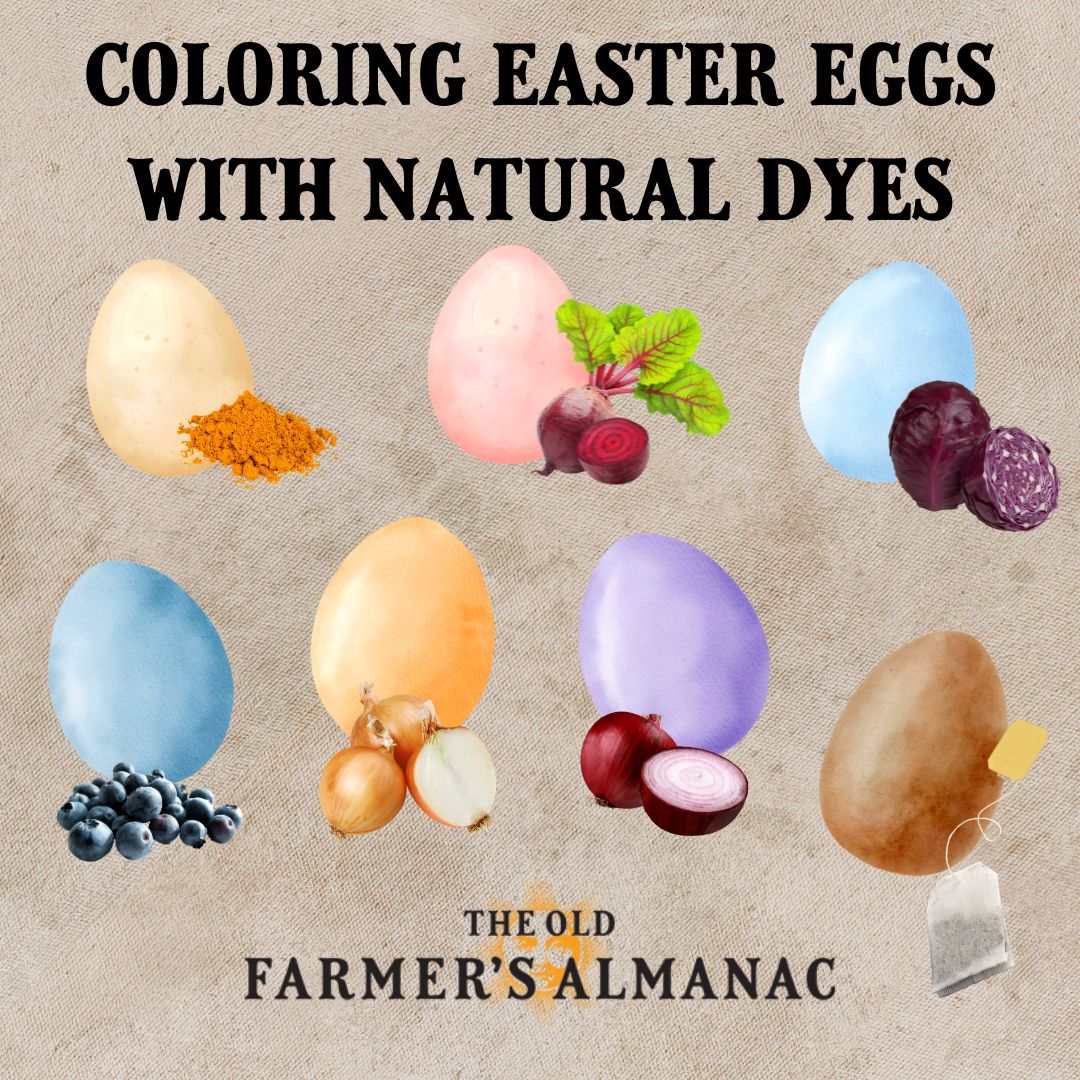Try coloring eggs the old-fashioned way—using spices, food, and plants! It turns out that items in your kitchen pantry and nature can provide all you need. This year, try coloring your Easter eggs without any chemicals or artificial dyes!
Note: You’ll want to color these eggs at least one day in advance for the most vivid shades.
(When is Easter this year? Click here!)
The Easter egg symbolizes new life, and coloring eggs has been a long-standing tradition. Sure, those artificial tablets make some fun, bright colors, but there’s a better way to color your hard-boiled eggs—pickling with all-natural dyes. From turmeric to blueberries to beets, it’s neat (not to mention educational) to see how different foods create different colors; the eggs “transform” without a magic wand!
Bonus: Add salt and sugar to the brine for salty-sweet eggs that you can later add to sandwiches, salads, and noodles. However, if you prefer to omit the sugar and/or salt, that’s fine, too.
Natural Easter Egg Dye Colors
Here are some different dye ingredients that we tested out and seem to work best:
- Yellow: Two teaspoons of ground turmeric to turn eggs yellow
- Pink: One cup of shredded beets to turn eggs pink (Shred on a box grater.)
- Blue: One cup of chopped purple or red cabbage to turn eggs blue
- Blue: One cup of blueberries to turn eggs blue
- Purple: One cup of red onion skins to turn eggs red or purple
- Brown: One bag of black tea to turn eggs brown
- Orange: One cup of chopped yellow onion skins to turn eggs orange

How to Make Natural Dyes for Easter Eggs
First, your eggs need to be at room temperature. (Take hard-boiled eggs out of the refrigerator about 20 minutes before you need them.)
For every egg color, you’ll want these ingredients:
- 1 cup water
- 1–2 teaspoons white vinegar
- Desired dye (turmeric, blueberries, beets, purple cabbage, etc.)
- Optional: 1 to 2 tablespoons salt
- Optional: 1 to 2 tablespoons light brown sugar (or regular sugar if you don’t have brown)
For example, if you’re selecting 4 egg colors, then you’ll need (at least) 4 teaspoons white vinegar, 4 tablespoons salt, and 4 tablespoons sugar.
A dozen eggs requires about 4 cups of solution.
Natural Easter Egg Dyeing Instructions
- Bring the water, salt, sugar, and dye ingredients to a boil, then turn down the heat to simmer the ingredients for about 30 minutes.
- Add 1 to 2 teaspoons of white vinegar to help the eggshell absorb the dye.
- Dip the eggs into the lukewarm solution. The longer they are saturated in the dyed water, the more vivid the color. We prefer to let the eggs sit overnight in a liquid bath to steep, but you can brine them from 8 hours up to 3 days.
- Let the eggs dry. We like to massage each one in a little vegetable oil and polish it with a towel.
Now, you can hide the colored eggs, eat the eggs, or use them as pretty decorations on Easter Sunday! Keep them cool in the refrigerator before you eat them!
Which colors are the brightest? Let us know!
How to Make Tie-Dyed Easter Eggs
Here’s another idea that the older kids especially love—tie dye!
- Hard-boil some large white eggs (use brown eggs for darker colors) and allow them to cool.
- Wrap a number of long rubber bands of various widths around each egg, covering the entire egg. The rubber bands should be long enough to wrap around the egg a couple of times. (If the bands keep popping off, don’t wrap them quite so tightly, or use thicker bands.)
- Dip the egg into homemade or store-bought dye.
- Remove from dye and let dry.
- Remove some or all of the rubber bands, then wrap them around the egg again and soak it in a different color until you have the shade you want.
- Allow to dry, and remove the rubber bands. You should now have a uniquely interesting egg.
Another way to create a tie-dyed look is by wrapping and twisting damp strips of cloth tightly around an egg.
- Drop different colors of dye onto the cloth and let the colors blend together.
- Let the egg sit until the cloth is dry, then carefully unwrap the egg.
We hope you enjoyed dyeing eggs this way, without the use of potentially harmful chemicals or artificial dyes!
Since you’re in the kitchen, check out our Easter Recipe ideas, including carrot cupcakes and more!











